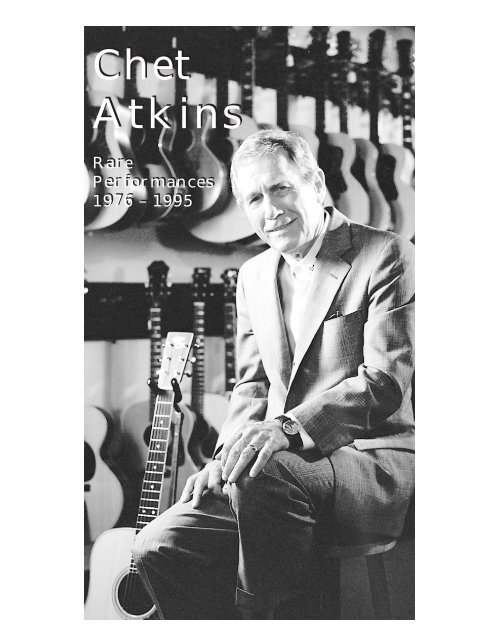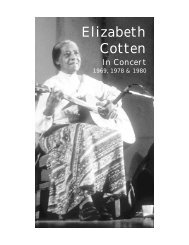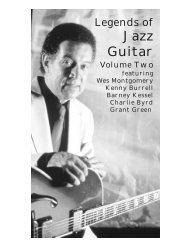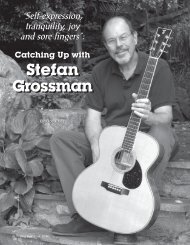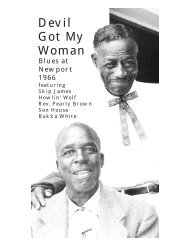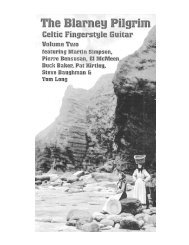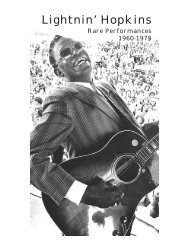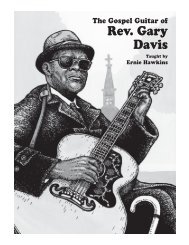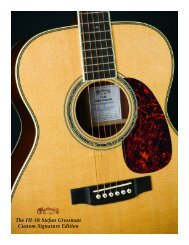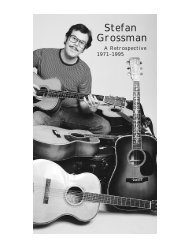Chet Atkins Chet Atkins - Stefan Grossman's Guitar Workshop
Chet Atkins Chet Atkins - Stefan Grossman's Guitar Workshop
Chet Atkins Chet Atkins - Stefan Grossman's Guitar Workshop
You also want an ePaper? Increase the reach of your titles
YUMPU automatically turns print PDFs into web optimized ePapers that Google loves.
<strong>Chet</strong><strong>Atkins</strong>RarePerformances1976 – 1995
CHET ATKINSRARE PERFORMANCES 1976–1995Photo by David A. Wolfram“I just had an insatiable appetite for the sounds of avibrating string of a guitar. I don’t know why, but I wascompletely taken by it. Some of my first memories werewhen I heard a chord strummed on a guitar.”– <strong>Chet</strong> <strong>Atkins</strong> to Bob Anderson, Pickin’ Vol. 6, No. 2 March 1979By his own account, he’s been playing guitar more thansix decades now. Viewed side by side, Vestapol’s two <strong>Chet</strong><strong>Atkins</strong> performance videos reflect 40 richly creative years.There are exceptions aside from <strong>Chet</strong>, of course, but preciousfew guitarists enjoy 40 year long careers – not onesthat anyone much notices, anyway. In the course of thosefour decades, <strong>Chet</strong> has managed to contradict most of ourprevailing stereotypes surrounding legendary guitarists. A selfdescribed‘square,’ he has never lived a particularly bohemianlifestyle, despite a few 1960s photos of him sporting anatty goatee. He has not, since his 1940s radio days, lived inanything resembling poetic poverty. (Being a child of the Depression-eraSouth, the poetic side of poverty is generallylost on <strong>Chet</strong>, who once knew what it was to go to bed hungry.)Obviously, he did not die young. He did not ‘play himselfto death’ (Charlie Christian), succumb to foul play over awoman (Robert Johnson), or OD (Jimi Hendrix). Nor has hemanifest, at least to the extent that it’s become apparent to2
<strong>Chet</strong> <strong>Atkins</strong> and Merle Travis Photo courtesy of <strong>Chet</strong> <strong>Atkins</strong>His acclaim was achieved without ever appearing astride ahorse strumming a guitar, the approach of the 1930s Westernguitar hero, or ever duck-walking with one, let alonesmashing or immolating an instrument. It was a fame basedin country music but which easily transcended generic boundaries.“His recorded music is strictly pop,” wrote John Grissim.“As a product, his records are purchased by consumers whoserecord collections include LPs by the Norman Luboff Choir,Ray Conniff, Henry Mancini...”<strong>Chet</strong>’s trophy room must be a wonder, for he’s won 13Grammys (not counting his 1993 Lifetime AchievementAward), nine Country Music Association Awards for Instrumentalistof the Year, the Academy of Country Music’s PioneerAward, and multiple readers’ poll honors from <strong>Guitar</strong>Player, Playboy, and other publications. (<strong>Guitar</strong> Playerdubbed <strong>Chet</strong> “Popular Music’s Most Influential Stylist.” Liferanked him sixth among the “100 Most Important People inthe History of Country.” ) In 1973, he became the youngestlivinginductee into the Country Music Hall of Fame (<strong>Chet</strong>was then 49). Twenty years later, <strong>Chet</strong> was honored with aLifetime Achievement Award from the National Academy ofRecording Arts & Sciences: “For his peerless fingerstyle guitartechnique, his extensive creative legacy documented onmore than one hundred albums, and his influential work onboth sides of the recording console as a primary architect ofthe Nashville sound.”4
Photo courtesy of <strong>Chet</strong> <strong>Atkins</strong>which was the homemadeentertainment inthe east Tennessee ‘holler’where <strong>Chet</strong> grew up.Most everyone played orsang, and <strong>Chet</strong> naturallyjoined in. “When you’rea kid,” he told Nash,“you want to be like youridols, and my idols weremy father and mybrother, so they inspiredme to play music.”<strong>Chet</strong>’s half-brother,Jim, was given a Washburnguitar shortly after<strong>Chet</strong>’s birth, and it wasa source of infantile fascinationto the futureCGP (Certified <strong>Guitar</strong>Player, <strong>Chet</strong>’s self-bestoweddegree). “I idolizedJim when he sat and played,” <strong>Chet</strong> wrote in his autobiography,Country Gentleman (with Bill Neely, BallantineBooks, New York, 1974). “When he wasn’t playing it, I touchedit a lot, rubbed my fingers lightly over the top, savoring thesilky varnish, and picking at the strings ever so lightly. Thesteel strings felt cold and magical to my small fingers.”<strong>Chet</strong>’s fixation on the guitar was excited further by a childhoodvisit to the big city of Knoxville, twenty miles to thesouth. “There I saw a blind man playing a guitar on the street,”he recalled in his autobiography. “I can still see him, withthat old, beat-up guitar and a tin cup tied close to the pegs.I can even hear the coins drop into the cup. When we gothome, I told Mother, ‘I wish I was blind and had a guitar.’That’s how much I wanted to play.”<strong>Chet</strong> wasn’t yet five when he first began playing a handme-downukulele. His interest in guitar was piqued anytimea visitor appeared with one. “People had started to dreadbringing a guitar to the house,” <strong>Chet</strong> wrote in his autobiography.“In moments I was all over them...My nose was alwaysabout three inches from the bridge of every guitar Isaw being played for the next few years.” And his eager at-6
tention soon bore dividends: “By the age of seven or eight,”<strong>Chet</strong> wrote, “I knew most of the major and minor first positionchords.” Intent on a guitar of his own, a nine-year-old<strong>Chet</strong> schemed to assume his brother Lowell’s hated morningmilking chores in exchange for a .22 rifle which heswapped (along with his own .30-.30 deer rifle) with theirstepfather, Willie Strevel, for a guitar. “It was a milestone inmy life,” <strong>Chet</strong> wrote. In time, he would also play a SearsSilvertone his stepfather got (along with $15) in trade for aModel T. That guitar, fitted with a saddle a 14 year old <strong>Chet</strong>made for it, is now in the Country Music Hall of Fame.But it was actually the fiddle that launched <strong>Chet</strong>’s entertainmentcareer. His Uncle Joe brought him one on a visitfrom Nebraska, and <strong>Chet</strong> was soon playing at the home-basedSaturday night country dances which are now a thing of legend,the kind of ‘house party’ where the carpets were rolledup and the furniture shoved out of the way. Soon <strong>Chet</strong> andhis brother Lowell were good enough to play at a schoolassembly, and the applause of 200 fellow students provedelectrifying. “I knew, at ten years old, that this was where Ihad to be,” <strong>Chet</strong> wrote, “out on some stage, or anyplace infront of people, playing the fiddle or picking the guitar.”It wasn’t unusual then for string players to play a varietyof instruments. What was exceptional was <strong>Chet</strong>’s determinedattitude at an early age, and a decision he reached at fifteen:he decided to concentrate on guitar, having heard that mostgreat violinists start by age seven. <strong>Chet</strong> decided he had beguntoo late, so from then on his every free waking moment,after classes and between chores, was devoted to guitar. “Iknew at 14 or 15 that the finger style would be the one I’duse for solos,” <strong>Chet</strong> told Bob Anderson. “I threw my straightpick away and I’d get a toothbrush handle and make a thumbpick out of it. I just play rhythm and bass with the thumband melody with the first three fingers. It’s an imitation of atwo-beat piano player.”It was during this time <strong>Chet</strong> managed to catch a few broadcasts(“when conditions were right”) of Merle Travis viaCincinnati’s 50,000 watt radio station WLW. “He certainlystimulated my imagination as to what could be done with aguitar,” <strong>Chet</strong> wrote, but the fact that he only heard Travissporadically (and never saw him play while teaching himself)contributed to <strong>Chet</strong>’s unique variations on ‘Travis picking.’“It wound up great because I didn’t know what the hell7
he was doing,” <strong>Chet</strong> told Anderson. “I thought he was playingwith three fingers, so I started playing with three fingers.As it turned out, the style I played was sort of a pseudoclassicstyle, with the hands in a slightly different position.”The fiddle, however, earned <strong>Chet</strong> his first significant employmentin the medium that mattered most in those days,radio. A seventeen-year-old dropout, <strong>Chet</strong> found work as fiddlerfor comic Archie Campbell and singer Bill Carlisle onKnoxville’s 10,000 watt WNOX in 1942. When America enteredWWII later that year, <strong>Chet</strong> was given a 4-F defermentdue to chronic asthma. His guitar playing came to light informally,and station executive Lowell Blanchard offered <strong>Chet</strong> afeature spot on the ‘Mid-Day Merry Go Round.’ Blanchardencouraged <strong>Chet</strong> to learn as many kinds of songs as possible,telling him, “You’re gonna make it big someday, Chester,and you’ll need every song you can get.” Blanchard even gavehim a key to the station so he could listen to transcriptiondiscs at night and on weekends. “My brother (Jim) startedsending me ‘air checks’ of their performances so I could playand copy Les Paul’s choruses,” <strong>Chet</strong> told Dave Kyle (Vintage<strong>Guitar</strong>, Vol. 9 No. 11, August 1995). “There were some transcriptionsof George Barnes at the radio station and I’d copyand memorize some of his choruses; ‘It Had to Be You,’ thingslike that.”It was during his three years at WNOX that <strong>Chet</strong>woodsheded extensively and broadened his repertoire in away that paved the path for his ‘country-politan’ style in subsequentdecades. It was also during his WNOX days that drummerHerbie Fields introduced him to the vibrola, later knownas the vibrato or ‘whammy bar.’ A 1943 photo shows <strong>Chet</strong>with a Martin C-2 archtop on which he had added the earliestof many such devices which became trademarks of hisstyle.When he turned 21, <strong>Chet</strong> was nudged out of the WNOXnest by his mentor, Lowell Blanchard, who felt it was timehis young charge test his style at a more powerful station.<strong>Chet</strong> agreed and spent some six months at Travis’s old station,WLW, before being fired on Christmas Eve, 1945. “Audiencesweren’t nearly as sophisticated as they are now,” <strong>Chet</strong>explained to Dave Kyle when asked about being fired. “Backin those days, there were a lot of songs about death andlooking for a soldier’s grave and all these terrible bloodcurdlingsongs...I didn’t do any of that stuff. I played guitar and8
<strong>Chet</strong> <strong>Atkins</strong> and Les Paul Photo courtesy of <strong>Chet</strong> <strong>Atkins</strong>it sounded like two bad guitar players, I guess, so I didn’t dovery well at keeping a job.”The next four years of <strong>Chet</strong>’s career bear witness to that.Sometimes <strong>Chet</strong> was fired, and sometimes he chose to seekgreener pastures. From WLW he bounced to WPTF in Raleigh,North Carolina, where ‘Chester <strong>Atkins</strong> & His Talking Electric<strong>Guitar</strong>’ backed Johnnie Wright and Jack Anglin. In April 1946he debuted on the Grand Ole Opry accompanying Red Foley,only to quit when his solo spot on Foley’s show was cancelled.His cross-country trajectory over the following yearincluded stops at Richmond, Virginia’s Old Dominion BarnDance over station WRVA, KWTO (Keep Watching the Ozarks)in Springfield, Missouri, and Denver radio station KOA. It wasduring his Springfield stint that booking agent Si Simon tookan active interest in <strong>Chet</strong>’s career and began sending transcriptiondiscs of his performances to record labels. In August1947, RCA initiated a relationship with <strong>Chet</strong> which wouldlast nearly 35 years, but his first recordings for the label, includingthe instrumental, “Canned Heat,” were little noticed.Not three years after being nudged out into the biggerworld, <strong>Chet</strong> returned to Knoxville’s WNOX, this time with awife and infant daughter in tow. He worked awhile with‘Homer’ Haynes and ‘Jethro’ Burns, musicians who hid theirpenchant for swing-era jazz behind cornball comedy. Then9
<strong>Chet</strong> <strong>Atkins</strong> and Jerry Reed Photo courtesy of <strong>Chet</strong> <strong>Atkins</strong><strong>Chet</strong> backed Maybelle Carter and her daughters June, Helenand Anita. It was in the company of this incarnation of theCarter Family that <strong>Chet</strong> returned to Springfield’s KWTO andfrom thence to the Grand Ole Opry in 1950. The circle, thoughwide, was unbroken.<strong>Chet</strong> moved into a different Nashville from the one hehad left in 1946. During the interim, the future ‘Music City’had begun to develop as a hub of country recording activity.Previously, much recording was scattered afar: Dallas and,perhaps surprisingly to some, Los Angeles were both popularcountry recording centers in the 1940s. From 1947 through1949, <strong>Chet</strong>’s RCA sessions took place in Chicago, New YorkCity, and Atlanta. But when he returned to Nashville in 1950,he found not only employment on the Opry but opportunitiesas a session musician. He backed Hank Williams on the1952 session which yielded both “Jambalaya” and the portentous“I’ll Never Get Out of This World Alive.” It was duringthis time <strong>Chet</strong>’s friendship with RCA executive Steve Sholesled to his expanding role in A&R for RCA Nashville. “It wasmy most productive time,” <strong>Chet</strong> said of the early 1950s toJohn Schroeter (Fingerstyle <strong>Guitar</strong>, No. 10, July/August 1995).“I was ignorant, but I played with a lot of authority and energy.”The ‘authority and energy’ of <strong>Chet</strong> <strong>Atkins</strong> was widely apparentin his 30th year, 1954. That’s when his first LP, Gallopin’<strong>Guitar</strong>, appeared, along with the first (Gretsch CA 6120) ofmany guitars <strong>Chet</strong> endorsed and helped design for Gretsch.10
By 1957, the first strains of ‘the Nashville Sound’ were audibleon such <strong>Chet</strong>-produced hits as Jim Reeves’s “Four Walls.”As producer and executive at RCA for the next 14 years, <strong>Chet</strong>helped shape the recording careers of a host of memorableartists, including Don Gibson, the Browns, Skeeter Davis, FloydCramer, Willie Nelson, Charley Pride, Waylon Jennings, andDolly Parton, to name a few.<strong>Chet</strong>’s RCA era ended in 1981. He moved to CBS thefollowing year, and the 1983 album Stay Tuned teamed <strong>Chet</strong>with guitarists Larry Carlton, Earl Klugh, George Benson, andMark Knopfler. ‘Mr. <strong>Guitar</strong>’ made the jazz charts the sameyear he picked up his Pioneer Award from the Academy ofCountry Music. And, if that weren’t sufficient eclecticism, hebegan endearing himself to the folk-oriented audience ofGarrison Keillor’s A Prairie Home Companion. Given his rootsin old-time country radio, this move was a natural for <strong>Chet</strong>,of whom Keillor says: “He’s one of the few guitarists I knowwho plays songs so that you don’t need lyrics. There’s a vocalism,a singing, to his playing.”In defiance of commercial country’s trend toward everyoungeracts, <strong>Chet</strong> released Read My Licks, an album whichfeatures duets with artists from jazz (George Benson), rock(Mark Knopfler), and country (Steve Wariner) in 1994, his70th year. Given the fact that he is well past having anythingto prove artistically or needing the money, we can only assumethat <strong>Chet</strong> keeps recording because he still has a passionfor playing. Looking to the day when that passion isfinally silenced, Alanna Nash asked <strong>Chet</strong> how he would liketo be remembered. “To answer your question,” mused <strong>Chet</strong>,pondering his self-said epitaph, “I guess I’d like for peopleto say I played in tune, that I played in good taste, and that Iwas nice to people. That’s about it.”11
THE PERFORMANCESPhoto by David A. Wolfram“When I played,” <strong>Chet</strong> said of his early days to Bob Anderson,“I didn’t cause a lot of commotion. I first got recognizedwhen television came along, and people could see one guitarplaying like two. That’s when I started getting attentionin Nashville.” <strong>Chet</strong> may have paid his dues in the days of‘live’ radio, but his national popularity indeed parallels thevideo age: his first chart hit, “Mister Sandman,” appearedearly in 1955. This collection of <strong>Chet</strong>’s video hits opens witha performance from 20 years later from Pop Goes the Countryof <strong>Chet</strong> trading licks with the man who affectionately callshim ‘the Chief,’ Jerry Reed. <strong>Chet</strong> has called Reed “a greatcomposer,” and the two ace fingerpickers go toe to toe (ornail to nail) on “I’ll Say She Does,” an original by the manaptly dubbed ‘the Claw.’From a 1978 Pop Goes the Country, <strong>Chet</strong> performs a slackkey guitar instrumental titled “Hawaiian Wedding Song”.<strong>Chet</strong>’s sense of humor is heard after his performance as hetries to give Ruth Buzzi some guitar tips.From the 1978 Chicago TV show, Soundstage, <strong>Chet</strong> doesa set of four tunes beginning with “Cascade” and then theBob Dylan standard “Don’t Think Twice It’s All Right” followedby “Kentucky”. The set ends with Guy Van Duser’s arrangementof “Stars And Stripes Forever”.The qualities of clean understatement which made <strong>Chet</strong>the consummate studio pro are amply evident in his 197912
Pop Goes the Country performance of “You Needed Me,” a1978 ‘crossover’ hit (#4 country, #1 pop) for Canadian songstressAnne Murray. Note <strong>Chet</strong>’s impeccably clean ‘manual’tremolo and, at the end, harmonics. This is followed by thepop hit “Dance With Me” which features great duet harmonyparts played with Paul Yandell.From a 1980 Pop Goes the Country performance <strong>Chet</strong>plays “Malaguena” from his classical repertoire. From a 1982Pop Goes the Country <strong>Chet</strong> performs “Sukiyaki” followed byKris Kristoferson’s “Me And Bobby McGee”.In 1987, Larry Carlton joined <strong>Chet</strong> on Austin City Limitsfor a study in funk called “Knuckle Buster” which finds <strong>Chet</strong>putting a delay unit to work.<strong>Chet</strong>’s unorthodox yet effective attack on classical guitaris apparent in “Sunrise,” performed on Austin City Limits in1991. He uses a thumbpick as a flatpick and as a close teammateto his index finger for a violin-like staccato.“The first music I ever heard came from my father,” <strong>Chet</strong>wrote in his autobiography. “I would listen as he shaved inthe morning, going through his vocal exercises in a beautifultrained Irish tenor voice.” Later, he would live nearly six years(from age 11 to 17) with James Arley <strong>Atkins</strong> and a youngstepmother in Georgia, where <strong>Chet</strong> perfected the rudimentsof his guitar style. His affection for his father is evident in “IStill Can’t Say Goodbye,” also from Austin City Limits in 1991.“Rainbow,” with the able accompaniment of Paul Yandell,is reprised at the 1992 Merle Watson Festival. Next, <strong>Chet</strong> deliversa deadpan revision of “There’ll Be Some ChangesMade,” complete with fuzz guitar solo and a lyrical lift fromhis friend Mark Knopfler’s “Money For Nothing.” The original1921 song was popularized in 1928 by Sophie Tucker, ‘Lastof the Red Hot Mamas,’ an artist with whom <strong>Chet</strong> wouldseem to have little in common. “Yankee Doodle Dixie” followswhich has become a challenge for all fingerpickers.The medley of ‘picker’s favorites’ is classic ‘country’ <strong>Chet</strong>reminiscent of his early 1950s recordings. Doc Watson, whois an appreciative audience throughout this segment, oftenlikes to introduce “Windy and Warm” by saying, “John D.Loudermilk said he wrote this to get <strong>Chet</strong> back to more countrypickin’.” While Doc popularized the tune for folk audiences,<strong>Chet</strong> introduced it in 1961 on his Down Home album. <strong>Chet</strong>calls “Windy and Warm” “a great fingerpicking tune, one ofmy most successful solos.”13
Paul McCartney and <strong>Chet</strong> <strong>Atkins</strong> Photo courtesy of <strong>Chet</strong> <strong>Atkins</strong>It’s followed in the medley by “Mister Sandman,” the1954 Chordettes pop chart topper which became <strong>Chet</strong>’s firstcountry chart entry in 1955. ‘<strong>Chet</strong> <strong>Atkins</strong> and his Gallopin’<strong>Guitar</strong>’ rode their version to #13 on the country chart.“Wildwood Flower,” next up in this medley, was the tune<strong>Chet</strong> played at his first noteworthy performance when hewas 10. He recalls being surprised to hear the Carter Familyrecording some years later, since it was a tune everyonewhere he grew up in east Tennessee knew. <strong>Chet</strong>’s fans havesometimes remarked that they prefer “Wildwood Flower” asan instrumental, since the lyrics “don’t make any sense.” That’sbecause it’s a casebook example of a folk song cobbled togetherfrom different sources in a manner mystifying to logicalexplanation. Maybelle Carter remarked, “My grandmotherknew that song,” and folklorists trace it to a couple of Victorian-eraparlor songs, “I’ll Twine Midst the Ringlets” and “ThePale Amaryllis.”“The Bells of St. Mary’s” follows, a gem <strong>Chet</strong> first recordedin 1953. Rich Kienzle calls his “sparkling fingerstyle version”of this 1917 vintage tune (popularized by Big Crosby in a1946 film of the same name) “among his most memorableperformances, even today.”The fifth number in <strong>Chet</strong>’s medley, “In the Good Old Summertime,”is older yet: it shares with “The Entertainer” a 1902publication date. <strong>Chet</strong> may have been inspired to play it bythe 1952 version of Les Paul and Mary Ford.14
“Freight Train” is the Elizabeth Cotten song which taughta generation of fingerpickers how to play. Trains played abig role in the imaginative life of rural children in early 20thcentury America. Libba Cotten was only 12 when she wroteher famous song, a response to train-inspired insomnia. <strong>Chet</strong>recorded his version in 1963. In his autobiography, <strong>Chet</strong> wroteof his early childhood: “As I lay in my bed and listened to thelonesome sound of the whistle from a freight train, I oftenbecame scared.”“Yakety Sax” was a 1963 hit (produced by <strong>Chet</strong>) for theking of the hillbilly honkers, Boots Randolph. Two years later,<strong>Chet</strong> enjoyed his highest chart record with “Yakety Axe,”which went to #4 on the country charts. Here <strong>Chet</strong> fits thetune to some tongue-twisting lyrics supplied by his mentor,Merle Travis.<strong>Chet</strong>’s Merle Watson Festival appearance closes with thecooking “Young Thing,” its sprightly boogie groove belyingthe fact that the tune was written by <strong>Chet</strong> for a friend dyingof Lou Gehrig’s Disease. It opens the Read My Licks albumand won a Grammy for Best Country Instrumental.The final two selections are excerpted from a <strong>Guitar</strong><strong>Workshop</strong> instructional video and were recorded at <strong>Chet</strong>’shome studio. The unusual classical guitar <strong>Chet</strong> plays is onehe helped design with luthier Kirk Sand of Laguna Beach,CA. “Happy Again” is a fairly recent original composition.“Lover Come Back” is a 1932 Rodgers and Hart song writtenfor the film Love Me Tonight, in which Jeanette MacDonaldsang it. Les Paul made a hot recording of it in 1948. Throughoutthis closing segment, it’s quite apparent that a 71 yearold <strong>Chet</strong> <strong>Atkins</strong>’s lifelong love affair with the guitar remainspassionate.– Mark Humphrey15
Running time: 71 minutes • b/w & colorFront cover photo by Tom NeffBack cover photo by Raeanne RubensteinNationally distributed by Rounder Records,One Camp Street, Cambridge, MA 02140Representation to Music Stores by Mel Bay Pub.® 2001 Vestapol ProductionsA division of <strong>Stefan</strong> <strong>Grossman's</strong> <strong>Guitar</strong> <strong>Workshop</strong>, Inc.For more than 40 years, the nameof <strong>Chet</strong> <strong>Atkins</strong> has been associatedwith the finest Nashville-basedfingerstyle guitar sounds. Eventhose records he did not play onshowed his influence. Yet his ownartistic growth never ceased, as isevident in this second volume ofVestapol’s chronological documentationof <strong>Chet</strong>'s career. We seethis gentle genius exploring themusic of Bob Dylan (Don’t ThinkTwice It’s All Right), marching bandcomposer John Phillip Sousa (Starsand Stripes Forever), pop standards(Lover Come Back) and progressivefunk (Knuckle Buster). <strong>Chet</strong>’s tonalpalette draws varied colors fromelectric guitars, nylon-strung classics,and even a resophonic guitar.Foremost in this collection are histraditional strengths as a tastefulsoloist, but we also see him swaplicks with the fiery Jerry Reed andLarry Carlton. The overall impressionmade by these performances isone of a master quietly demonstratinghis continued primacy inhis field and doing so with a calmassurance unabated by needlessgrandstanding.Pop Goes The Country, 1976 I'll Say She Does Pop Goes TheCountry, 1977 Hawaiian Wedding Song Soundstage, 1978Cascade, Don't Think Twice It's All Right, Kentucky, Stars andStripes Forever Pop Goes The Country, 1979 You Needed Me,Dance With Me Pop Goes The Country, 1980 MalaguenaPop Goes The Country, 1982 Sukiyaki, Me and Bobby McGeeAustin City Limits, 1987 Knuckle BusterAustin City Limits, 1991Sunrise, I Still Can't Say GoodbyeMerle Watson Festival, 1992 Rainbow, There'll Be SomeChanges Made, Yankee Doodle Dixie Medley: Windy & Warm/Mr.Sandman/Wildwood Flower/The Bells Of St. Mary's/In The GoodOld Summertime/Freight Train/Yakety Axe, Young ThingAt <strong>Chet</strong>'s Home Studio, 1995Happy Again, Lover Come BackVestapol 13091ISBN: 1-57940-911-30 11671 30913 2


